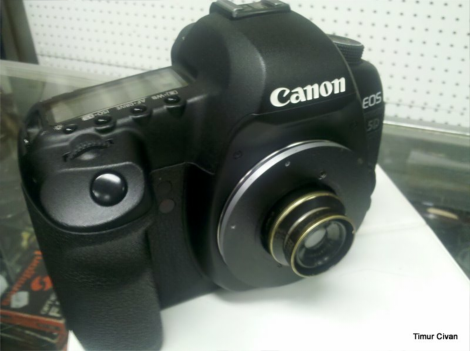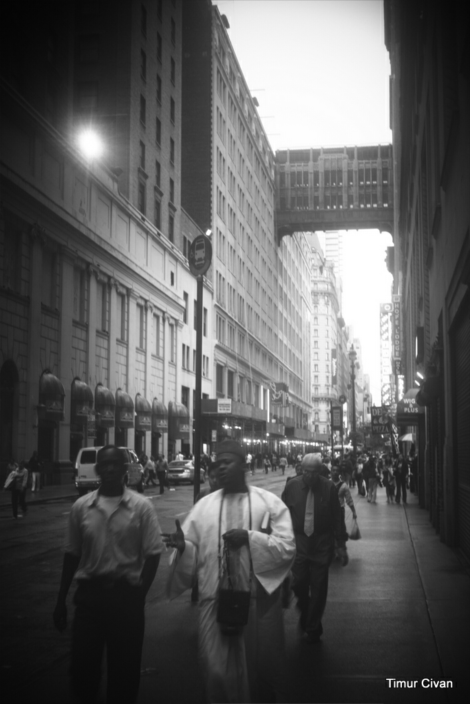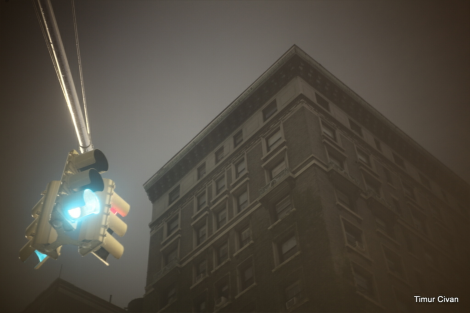
[Timur Civan], with a beautiful merge of past and present, has taken a 102 year old camera lens (a 35mm F5.0 from hand cranked cinema cameras) and attached it to his Canon EOS 5D. While this is not the first time we’ve seen someone custom make a camera lens or attach a lens to a different camera, such as when we brought you plumbing tilt shift or iPhone camera SLR or Pringles can macro photography, the merge of old tech with new warms our empty chest cavities hearts. Catch some additional shots of 1908/2010 New York City after the jump.


















i like the combination of “canon artifacts” caused by canon cameras and the artifacts of the old lens
it gives a nice touch of old photography without the pain of film
@biozz
Yes, the lack of clearity and high noise found in canon cameras today makes a great mix with old lenses to produce an old effect and gives new life to cameras that professional photographers tend to throw aside.
Gotta love the mouseovers!
i want to see what it looks like on a nikon!
What exactly are “Canon” artifacts? I don’t really see anything in those pics other than what’s to be expected from a lens of that type and age. Which is beautiful of course but I’ve never heard of Canon artifacts before and I’ve been shooting Canon for quite some time.
the take your mouse off me alt text was praobably taken from doghouse diaries
Nice, but the focal length of a lens is determined by the image area — unless this is from a 35mm projector, the length is different in this application.
Biozz — the 5D is a full frame camera, so it has very low noise.
Umm, the focal length of a lens is determined by the lens, not by the image area.
The magnification of the image however, is determined by the size of the film plane/sensor.
For example in a 35mm format camera the lens needs to be around 50mm for you to have a “normal” magnification. Or in other words, similar to what you see out of your eye.
When you scale up for example to 120 format the lens focal length needs to increase to about 75-80 for you to have a “normal” magnification.
One thing I would never spend money for, stupid expensive cannon cameras. Every crappy phone has 2 megapixel cams now.
lol, never realised hack a day had alt text
@ HFH
Just because you have no use for something doesn’t mean it’s crappy.
For starters DSLR’s have way more than 2 megapixels so on that alone its valid.
However the significant difference is that phone-cameras don’t tend to have things like shutters and apertures which are both a must if you want full control of your image.
For example you can’t do a long exposure photograph on a camera-phone because there is no way to regulate light coming in other than to just activate and deactivate the sensor. If you have no aperture to close down the amount of light coming in the image will quickly become blown out.
Simply recording an image for posterity is not synonymous with photography as a medium.
Also, since when are Canon camera’s high noise? They aren’t any worse than any other DLSR like Nikon and such. The noise is just a product of the nature of CMOS sensors. You only really notice it if you bump up the ISO or if you have the sensor running long enough to get hot.
This is a very cool retrofit. I like the very 1920’s feel I get from those images. (Yes, I know it’s from 1908.) I would definitely do this kind of mod if I had an old lens lying around.
That said, Renee is right. The newer Canon (Nikon, etc) cameras show almost no noise/artifacts at low ISO. Even at full resolution on a computer screen. I’m not sure what the other posters meant (or if they were just bashing Canon?), but it doesn’t make much sense.
@HFH
Yep, no reason for crappy expensive computers either. I picked up this C64 for next to nothing and it’s great for posting on HaD.
@Renee
Megapixels have no effect on clarity of picture. I have had 5MPx cameras that shoot like crap and 2MPx cameras with a zeiss lens that will blow your mind. Optics are a much bigger deal.
Yeah, I know that. I was just pointing out that if you’re going to judge something based on a raw, face-value approach that doesn’t really leave you with any point.
If just megapixels alone is one’s argument then it falls short because DSLR’s have waaay more.
But yeah, there are tons of factors that have to be weighed if you want to judge what makes a camera good or not.
Also, I must be going blind or something because I can’t see ANY noise in any of the photos. Unless I’m missing some link to a super high-res version of the pics or something.
There is just no way to see noise in an image of that size. I see some definite vignetting (which I love) but I’m guessing that’s because the original lens was designed for film format 35mm and not still image.
biozz chill it, troll. Let’s see you pack your Sinar X in a shoulder bag and get on the subway.
Yea it does look goofy. I surprised n one characterized it as steam punk.
why would the quality or name of the equipment matter here, this is art and if you make an image using whatever method you need to produce it then does it really matter which one you chose (unless it has symbolic significance)
A couple of them show a tiny bit of noise in the shadows, but no more than any other high end camera would in the same situation. Possibly more noise gets introduced in the PP than in the camera anyway.
Canon does have its slight differences from Nikon but only a pro photog would ever find them limiting, and only if they had a specific repeatable task that worked in that envelope. I think the problem is people with no idea about cameras other than “it takes a photos with X pixels” commenting. Older Canons have “a lot” of high ISO pattern noise making them less good for short exposure low-light shots, but that “lot” isn’t even remotely close to the amount noise from a 2 or 5MP compact of a couple of years ago, or any phone camera.
Lenses effect sharpness and colour rendition, not noise.
Nice shots anyway, and I like the hack, even if it does seem to be purposefully disabling the camera!
The main reason these shots look the way they do is that the lens was probably only intended to cover at most a 16mm frame, instead of the Canon’s full size 35mm sensor, so of course the image goes dim and foggy outside of this zone, and even in its design footprint it’s not as sharp as more modern lenses.
In the other direction you can use surplus copy lenses as mid-range telephotos; they are much longer and heavier than regular camera lenses but because they were designed to cover a very wide, very flat field at very high resolution they make really fine images.
If it ain’t broke, don’t fix it
On the other hand, more megapixels are not so bad. In the end More Megapixels end up compensating for noise.
I can go more into debating but then there is no requirement since we are not discussing DSLR’s or image sensors.
I don’t think past issues with Canon cameras equals “canon artifacts,” besides Nikon has its own issues too.
Both Nikons, Canons and frankly all DSLR’s have their own versions of noise and you can’t really single one of them out.
But then again I shoot Canon so maybe I’m biased.
But then again all my friends shoot Nikons of various cost and they all have noise issues of varying degrees and it all overlaps really.
When I read “Canon noise” I think “noise specific to Canon” or “unique noise that Canon has.” As if there is this distinct and special form of noise generated from Canon cameras.
But that’s not really what it is. It’s more like older Canon’s were prone to having this generic thing called “noise” more so than other cameras.
My brain is seriously obsessed with language and semantics.
“On the other hand, more megapixels are not so bad. In the end More Megapixels end up compensating for noise.”
Actually more megapixels add more noise since its mean the physical size of each pixel become smaller so less light is captured by each which often result in pink noise
Assuming you’re talking about the same size sensor, but yeah totally.
That’s why I avoid some photo stores. “But this model has a million more pixels than the other model, it’s better!!” Uhh, yeah….
Does anyone happen to know of a good resource that lists pixel pitch, number of pixels and sensor size? That would be awesome.
I think most of the lower consumer model Nikon’s and Canon’s have roughly the same size sensor and pixel count. I know that there is definitely some major overlap when you look at the full lineup. Which is partially why I reject the idea of singling any one particular out as being bad.
I’m doing this with one of the new hd webcams and old camera lenses. I hate that they paired a plastic lens with fixed focus on such a nice megapixel sensor.
Hope it improves the quality .
I prefer film and my 116 yr-old lens came with my 116 yr-old camera ;)
http://twitpic.com/2sts1l
There was definitely some post production going on in these. That takes away all merit of the lense’s true performance.
Crop? B&W? Come on, show us an untampered shot or two.
Most lenses that were built with out a multi-coating will appear to be able to capture a somewhat acceptable image in b/w. But look at a color image and you will notice it right away. Colors will mix and appear over exposed.
This is taught at most photography schools in what most see pre-1960 lenses…. ???
Want some interesting results? Take a Rodenstock lens, called the Imagon, and use it. Creates some very interesting reflective surfaces and generates great skin tones. That is why it was invented for cinematography– it has one convex element and different hole apertures.